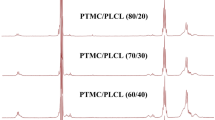Abstract
Four polyurethanes that were synthesized with different hard segments as well as four commercial polyurethanes were investigated for in-vivo biostability. The four polyurethanes with the varying hard segments were based on a 3/2/1/ mole ratio of methylene diphenylene diisocyanate (MDI) or methylene dicyclohexylene diisocyanate (H12MDI); butanediol (BD) or ethylene diamine (ED); and polytetramethylene oxide (PTMO) (MW=1000). Two commercial polyurethanes were also used: Biomer (Ethicon, Inc.) and Pellethane (Dow).
Films of the polymers were implanted subcutaneously in rats for up to three months to assess their biostability. Polymer films were implanted with either a 100% strain applied or in the unstressed state. Measurement of tensile properties and surface properties before and after implantation was used to assess the stability of each of the polymers. Surface cracking was observed with scanning electron microscopy and the extent and depth of cracking was determined.
It was found that BD chain extended polymers maintained their tensile properties better than the ED chain extended polymers after implantation. H12MDI-based polyurethanes were more susceptible to surface cracking than MDI-based polyurethanes, possibly due to the lack of a crystallizable hard segment.
Similar content being viewed by others
References
J.H. Boretos and W.S. Pierce, Science 158 1481 (1967).
M.D. Lelah and S.L. Cooper, Polyurethanes in Medicine (CRC Press, Boca Raton, FL, 1986).
B.D. Ratner, K.W. Gladhill, and T.A. Horbett, J. Biomed. Mat. Res. 22 509 (1984).
R.J. Thoma and P.E. Phillips, J. Biomed. Mat. Res. 21 525 (1987).
K.B. Stokes, in Polyurethanes in Biomedical Engineering, edited by H. Planck et al. (Elsevier Science Publishers, New York, 1984), p. 243.
A. Takahara, A.J. Coury, R.W. Hergenrother and S.L. Cooper, J. Biomed. Mat. Res. 25 341 (1991).
A. Takahara, R.W. Hergenrother, A.J. Coury and S.L. Cooper, J. Biomed. Mat. Res. in press.
J.H. Saunders and K.C. Frisch, Polyurethanes: Chemistry and Technology (John Wiley and Sons, New York, 1960).
K.K.S. Hwang, G. Wu and S.L. Cooper, J. Polym. Sci, Polym. Chem. Ed. 22 1677 (1984).
R.W. Hergenrother, H.D. Wabers and S.L. Cooper, J. Appl. Biomat. in press.
Author information
Authors and Affiliations
Rights and permissions
About this article
Cite this article
Hergenrother, R.W., Cooper, S.L. The Effect of Hard Segment Chemistry on the In-Vivo Biostability of Polyurethanes. MRS Online Proceedings Library 252, 257–263 (1991). https://doi.org/10.1557/PROC-252-257
Published:
Issue Date:
DOI: https://doi.org/10.1557/PROC-252-257




